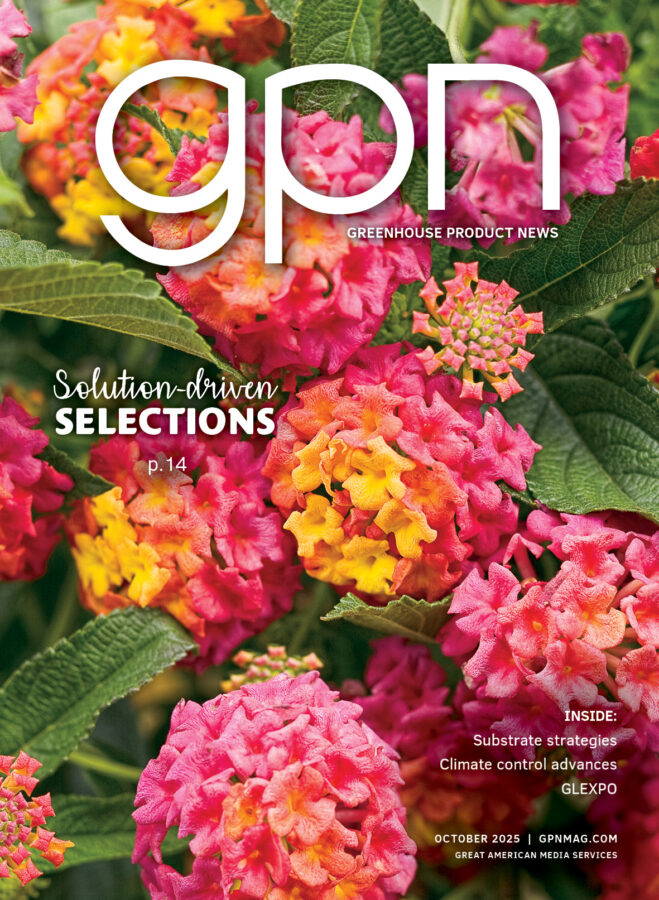Grower 101: Water Disinfection
Proper water management is crucial in today's marketplace: With increasing costs and competition, saving money when it comes to water and fertilizer has become necessary to keep production costs down. As soilless growing can create large amounts of wastewater that ends up being released into the environment, many owners are looking at alternatives for their current run-to-waste systems.
A closed recirculation system works by recycling wastewater from the greenhouse and storing it in a covered holding tank. A challenge of recycling wastewater is the increased risk of spreading water-borne diseases throughout crops. To reduce this risk it is necessary to disinfect wastewater before it returns through the system.
There are a number of disinfection systems available that will destroy water-borne pathogens and organisms; they all offer benefits and challenges. The primary systems currently being used to recycle wastewater are heat pasteurization, ozonation and UV disinfection.
Heat Pasteurization
Heat pasteurization is the most widely used system due to its simple design and low maintenance. It is effective against viruses, bacteria, fungi and nematodes. The recirculated nutrient solution is run through a 50-70 micron filter, and the pH is reduced to 4.5 before being exposed to the heat exchanger. The filtered and pH-adjusted solution is then pumped to the first heat exchanger. The first-phase heat exchanger pre-heats the filtered water, recovering heat from the sterilized nutrient solution that is exiting the pasteurization unit on its way to a post-treatment storage facility.
The incoming water is then pumped to a second heat exchanger where an external heat source (a boiler) heats the nutrient solution to the desired temperature. The recommended temperature for the second heat exchanger is 203¡ F. The nutrient solution to be sterilized must be exposed to this temperature for a minimum of 30 seconds.
After the sterilization process is complete, the solution is returned to the first heat exchanger for cooling and pre-heating of the incoming solution. The sterilized water is stored in a separate tank until it is required. The treated solution is often analyzed and nutrient adjustments are made before it is reused.
Approximately 200 cubic ft. of gas will be required to sterilize 1,000 gal. of recirculated nutrient solution. The capacities of the pasteurization units should be in the range of 5-200 gal. per minute. Although this system employs a simple concept, the cost to run it can be quite expensive, especially considering current energy costs.
Ozonation
Ozone is a powerful oxidizing agent used to disinfect drinking water, but unlike chlorine, ozone does not result in chlorinated by-products. It offers high kill rates on fungi, bacteria and viruses. Ozone reacts quickly and has no residual capacity. It acts as a donor of electrons (hence oxidation) to other substances. After the donation of electrons, ozone is itself converted to oxygen.
After filtering the returning drain water with a 50-70 micron filter, the water is pumped into a treatment tank where ozone is injected. The pH of the treated water should be lowered to 4.0-4.5 to achieve optimum results. Bacterial tests on commercial installations indicate that treating roughly 3 cu.ft. of drain water for 1 hour with 10 grams of ozone is sufficient to achieve the required disinfection. In early experiments with ozone, the gas would often escape from the ozonation tank into the open air, which cannot be permitted. Ozone is environmentally safe when it is injected and contained in a closed tank and the residual ozone is destroyed.
Ozone treatment at the rate of 1.4 oz. per hour per 1,000 gal. of water or a redox potential of 764 millivolts is used in Europe. It is effective against viruses, bacteria and fungi and preferred by technically minded growers, but the process is more expensive to operate than heat pasteurization.
UV Disinfection
UV stands for ultraviolet light. UV radiation, like light, is part of the electromagnetic spectrum and is invisible to the human eye. It is defined by two factors: frequency and wavelength. Frequency determines the radiation energy while wavelength determines the type of radiation. There are three types of UV radiation based on wavelengths. Of these, UV-C is most suitable for the disinfection of water and air as it has the shortest wavelength and the highest energy.
UV-C rays, the most effective UV rays with a wavelength of 254 nanometers, have a lethal effect on microorganisms such as bacteria and fungi and render viruses inactive. The water needing disinfection is passed through a radiation chamber at a specific rate in the disinfection unit. In that chamber are one or two high-pressure UV lamps contained in a quartz tube. A computer controls and protects the total disinfection process.
There are high-pressure and low-pressure UV systems. In greenhouse horticulture, the water to be disinfected may have a poor transmission rate for efficient penetration of UV rays. The use of the very powerful, high-power UV lamps means it is no longer necessary to dilute drain water with reservoir water as long as the transmissivity of the water is greater than 20 percent. One high-power UV lamp is as powerful as several low-power UV lamps.
The UV dose is monitored continuously. If the dose is too low, the process is blocked, and the inadequately disinfected water is automatically returned to the drain-water tank. This means that the crop never comes into contact with inadequately disinfected water.
The UV radiation is powerful enough to make viruses, fungi and bacteria harmless. Biological tests at the Research Station for Horticulture and Greenhouse Vegetables in Naaldwijk, The Netherlands, have established the minimum radiation dose needed to prevent disease when disinfected water is used on young test plants. The dose for selective disinfection (fungi, bacteria) is 80 millijoules per cubic cm., while it is 250 millijoules per cubic cm. for total disinfection.
In addition to the primary systems, secondary systems are also available. They include slow filtration, ultra filtration, hydrogen peroxide and iodine.
Slow Filtration
Slow filtration has been used for centuries to clean drinking water. At the present time, it is being used by rose and potted crop nurseries, and tomato growers are also using some form of slow filtration. Slow filtration can be achieved through the use of layered sand or rock wool.
The filter medium is the most expensive component of the system, and the quality of the medium required is what makes the system costly. Sand must be double washed with water at a pH of less than 4.0, and it must have a grain size of 0.2-2 mm. The column height of the system, regardless of the medium, must be greater than 30 inches.
The basic principle is that water slowly travels through several layers of medium at a rate of no greater than 4-12 inches per hour. Antagonists, which are allowed to develop in the system, catch the pathogens and prevent them from traveling through the system. For best results, the filter speed should be as slow as possible. In order to eliminate Pythium, a filter speed of 24 inches per hour is adequate; however, for other pathogens (e.g., Fusarium) the filter speed must be much slower.
At the present time in Europe, slow filtration is gaining in popularity among tomato growers. Upon examination, there are many reasons for this: It has a low initial set-up cost; no major technical problems to overcome (e.g., complex technology, electronics, etc.); no need to mess about with acids to adjust the pH of the solution; and no adverse effects on any nutrient compounds (e.g., chelates). Additionally, it is highly effective against most disease problems.
Ultra-Filtration
Ultra-filtration, also known as membrane filtration, is well known by many nurseries that have to deal with poor-quality water. Reverse osmosis or hyper filtration to desalinize irrigation water is an extreme example of ultra-filtration.
Ultra-filters and microfilters have more porous membranes than hyperfilter systems, thus allowing them to filter out suspended solids, colloids, bacteria and other particles. However, the pores of these types of filters tend to clog, making them relatively unreliable.
However, for the disinfection of recirculation water, this technology is not suitable since they also remove fertilizer salts from the water.
Hydrogen Peroxide
Hydrogen peroxide acts in a similar manner to ozone; however, it is a weaker oxidant. The treatment is under investigation in Europe, and studies have shown it to be effective against fungi and viruses but less so against bacteria.
In combination with activators and stabilizers, hydrogen peroxide has been effective against fungi when dosed at a concentration of 100 ppm. In order to kill viruses, the dose must be increased to 400 ppm.
High concentrations of hydrogen peroxide may cause crop damage if not neutralized before the nutrient solution is returned to the crop. Hydrogen peroxide is very environmentally friendly. It produces no residue and breaks down to oxygen and water.
Iodine
Iodine is used in drinking water because it kills human viruses. Unfortunately, horticultural viruses are not killed at iodine concentrations up to 15 ppm while fungi are killed at concentrations as low as 0.7 ppm.
The system requires both sand and a fine filter. After the pre-filtration treatment, 0.3-2 ppm of iodine is injected into the drain water and left for 10 minutes to react. After the reaction period, the water is then pumped through an activated carbon filter in order to de-active (absorb) the iodine. However, during the carbon filter process, iron and copper, two common greenhouse fertilizers, are adsorbed onto the carbon particles.
Research at Naaldwijk has found that 0.8 ppm of iodine is necessary and only 12 minutes of reaction time is required to kill most fungi. Generally, however, the system is not recommended due to poor reliability.
Most Popular Systems
The most popular disinfection systems used in Europe today, based on the number of systems in use and the nursery area they are servicing, are (in order of popularity) heat pasteurization, ozonation and UV radiation. This list does not preclude the development of more effective systems or environmentally sensitive systems in the future.









 Video Library
Video Library 


















